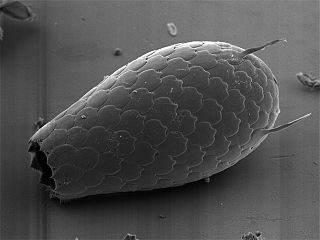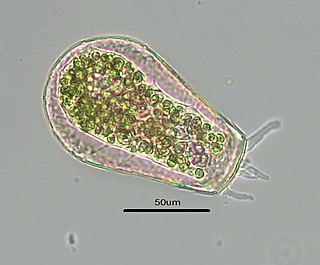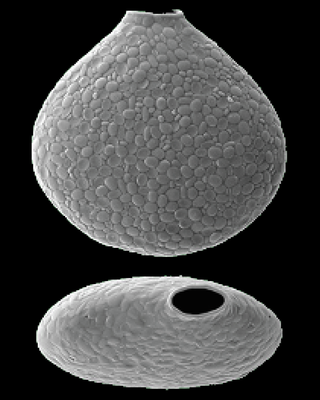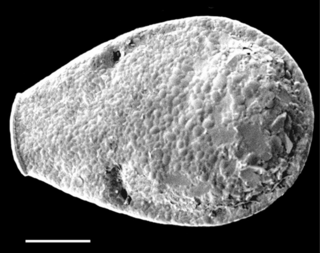
The Globigerinina is a suborder of foraminiferans that are found as marine plankton. They produce hyaline calcareous tests, and are known as fossils from the Jurassic period onwards. The group has included more than 100 genera and over 400 species, of which about 30 species are extant. One of the most important genera is Globigerina; vast areas of the ocean floor are covered with Globigerina ooze, dominated by the shells of planktonic forms.

The euglyphids are a prominent group of filose amoebae that produce shells or tests that in most described species is reinforced by siliceous scales, plates, and sometimes spines, but this reinforcement is absent in other species. These elements are created within the cell and then assembled on its surface in a more or less regular arrangement, giving the test a textured appearance. There is a single opening for the long slender pseudopods, which capture food and pull the cell across the substrate.

The Amoebidae are a family of Amoebozoa, including naked amoebae that produce multiple pseudopodia of indeterminate length. These are roughly cylindrical with granular endoplasm and no subpseudopodia, as found in other members of the class Tubulinea. During locomotion one pseudopod typically becomes dominant and the others are retracted as the body flows into it. In some cases the cell moves by "walking", with relatively permanent pseudopodia serving as limbs.

Difflugia is the largest genus of Arcellinida, one of several groups of Tubulinea within the eukaryote supergroup Amoebozoa. Arcellinida species produce shells or tests from mineral particles or biogeonic elements and are thus commonly referred to as testate amoebae or shelled amoebae. Difflugia are particularly common in marshes and other freshwater habitats.

The Tubulinea are a major grouping of Amoebozoa, including most of the more familiar amoebae genera like Amoeba, Arcella, Difflugia and Hartmannella.

Arcellinid testate amoebae or Arcellinida, Arcellacean or lobose testate amoebae are single-celled protists partially enclosed in a simple test (shell).

Testate amoebae are a polyphyletic group of unicellular amoeboid protists, which differ from naked amoebae in the presence of a test that partially encloses the cell, with an aperture from which the pseudopodia emerge, that provides the amoeba with shelter from predators and environmental conditions.

The vampyrellids, colloquially known as vampire amoebae, are a group of free-living predatory amoebae classified as part of the lineage Endomyxa. They are distinguished from other groups of amoebae by their irregular cell shape with propensity to fuse and split like plasmodial organisms, and their life cycle with a digestive cyst stage that digests the gathered food. They appear worldwide in marine, brackish, freshwater and soil habitats. They are important predators of an enormous variety of microscopic organisms, from algae to fungi and animals. They are also known as aconchulinid amoebae.

A protist is any eukaryotic organism that is not an animal, plant, or fungus. The protists do not form a natural group, or clade, since they exclude certain eukaryotes with whom they share a common ancestor; but, like algae or invertebrates, the grouping is used for convenience. In some systems of biological classification, such as the popular five-kingdom scheme proposed by Robert Whittaker in 1969, the protists make up a kingdom called Protista, composed of "organisms which are unicellular or unicellular-colonial and which form no tissues". In the 21st century, the classification shifted toward a two-kingdom system of protists: Chromista and Protozoa.

Hyalospheniidae is a family of arcellinid testate amoebae and the sole family of the infraorder Hyalospheniformes. Commonly referred to as "hyalospheniids", these lobose amoebae are characterized by their ability to generate a shell composed of either organic matter or siliceous particles that may be recycled from euglyphid amoebae. They inhabit soil or freshwater habitats, and are abundant on Sphagnum mosses.

Nebela is a diverse genus of testate amoebae of cosmopolitan distribution, belonging to the family Hyalospheniidae. They are "prey agglutinated" or "kleptosquamic" organisms, meaning they take the inorganic plates from their prey to construct their test.

Certesella is a genus of testate amoebae belonging to the family Hyalospheniidae. It is characterized by a test that presents two symmetrical holes near the opening, and by the presence of internal teeth within the test. It contains four species previously assigned to Nebela, as well as one species discovered in 2021.

Porosia is a genus of arcellinid testate amoebae belonging to the family Hyalospheniidae. Described in 1942, it used to be a monotypic genus with the sole species P. bigibbosa. However a second species, P. paracarinata, was discovered in 2015.

Cryptodifflugiidae is a family of arcellinid testate amoebae.

Meisterfeldia is a genus of arcellinid testate amoebae erected in 2016 that unites several new species as well as old species previously found in the genus Cryptodifflugia. Five of the newly described species were first found and isolated from subarctic tundra soil surrounding a river near Chokurdakh, Russia, while the last one, described in 2021, was recovered from tree hollows in Moscow.
Pseudocucurbitella is a genus of freshwater testate amoebae of the order Arcellinida. Its shell is agglutinated, ovoid, with a round crossection and a circular aperture surrounded by 3 to 5 separate lobes forming a short collar.

Planocarina is a genus of arcellinid testate amoebae belonging to the family Hyalospheniidae. It was created in 2016 to agglutinate a clade of species that were previously assigned to the paraphyletic genus Nebela. All species of Planocarina have a compressed keel surrounding the posterior part of their shell. It is the sister group of Alabasta.

Alabasta is a genus of arcellinid testate amoebae belonging to the family Hyalospheniidae. It contains species with an elongated test and a strongly curved "pseudostome" with a flare and a notch in narrow view. These species previously belonged to the genus Nebela, but were later found to be a distinct monophyletic group different from Nebela. It is the sister group to Planocarina.

Erugomicula is a genus of testate lobose amoebae found in the order Arcellinida. It was described in 2021 and tentatively placed in the family Hyalospheniidae, but it is also attributable to the family Difflugiidae, based solely on morphological characteristics. At present it is placed as incertae sedis within the larger Arcellinida group.

Corycidia is a clade of amoeboid protists within the eukaryotic supergroup Amoebozoa. It contains all amoebae of the families Microcoryciidae, which was previously regarded as Arcellinida, and Trichosphaeriidae, which contains the sole genus Trichosphaerium.


















